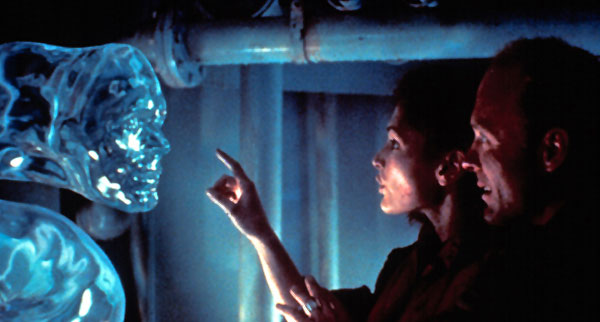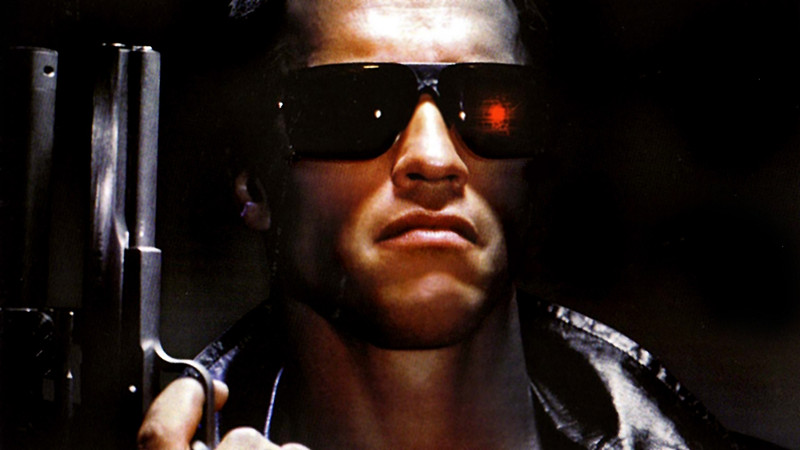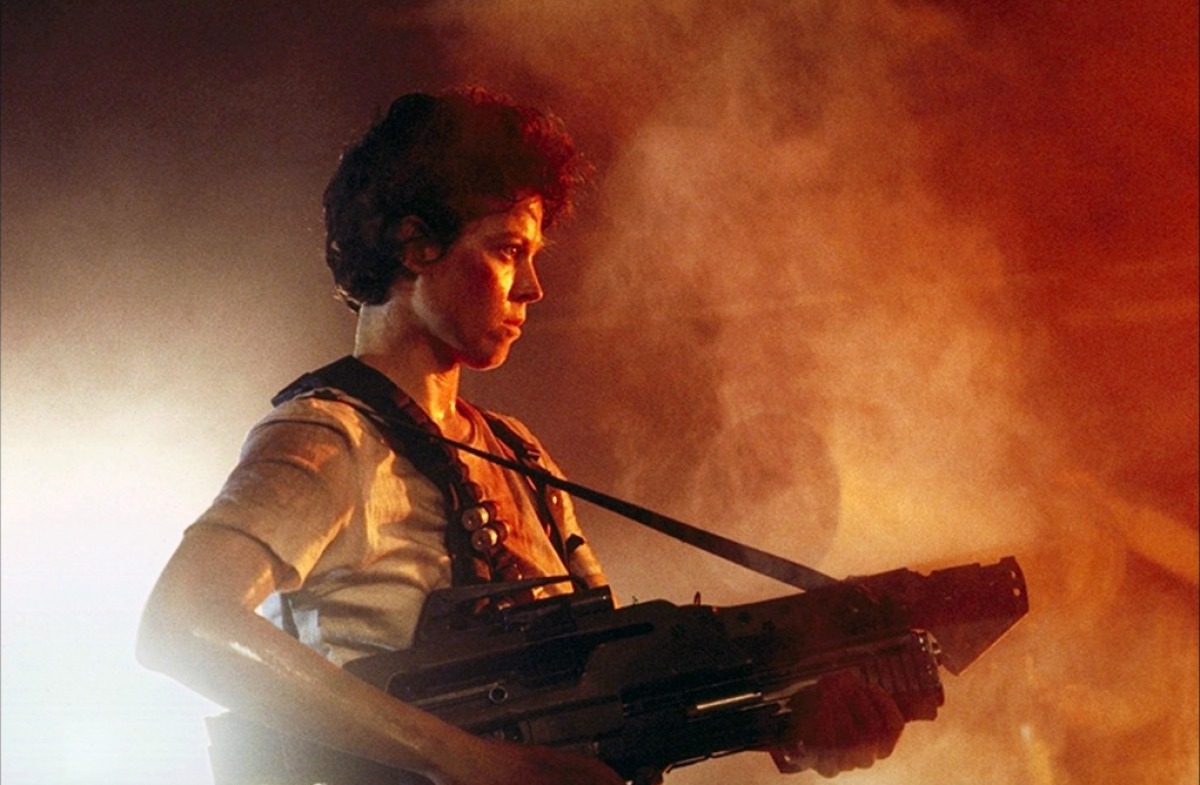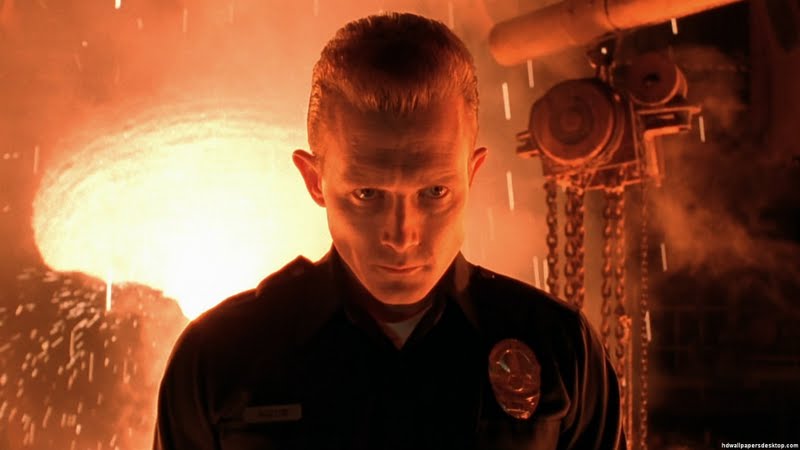5. The Abyss (1989)

The unknowable vastness of the deep ocean is gazed with wonder and chillingly conveyed in “The Abyss”, an unfairly maligned but ambitious title in Cameron’s oeuvre in which a crew of underwater oil rig workers survey the depths of the Caribbean Sea in order to find and recover a sunken nuclear submarine.
Though generally swept under the rug as a rare critical and financial flop among a line-up of zeitgeist smashes, “The Abyss” has enjoyed something of a renaissance lately, in no small part thanks to a brand-new director’s cut that fleshed out the story with a much-welcomed extra 30 minutes of runtime. At once an exhilarating thriller escapade, a Spielbergian first contact encounter adventure, and a watershed in practical and CGI effects, this waterlogged nail-bitter ticks off all of Cameron’s itches and trademark obsessions and stands as one of his finest efforts. As we greet the new “Avatar” movie, which heavily features underwater scenes, there has never been a better time to go 25,000 feet below the ocean’s surface and revisit this underseen gem.
4. The Terminator (1984)

Cameron announced himself in striking fashion with this futuristic slasher starring Arnold Schwarzenegger as T-800 — an unstoppable, cold-blooded cyborg assassin sent from the year 2029 to kill the mother of the human savior who one day will lead the resistance against the uprising of the machines.
As a film that would kick off an entire franchise, make an A-list star out of Schwarzenegger, and become buried under popular acclaim over the past four decades, it’s easy to forget that nobody knew “The Terminator” was going to be a smash hit upon its release. Cameron, whose credentials at the time were close to non-existent back in 1984, sold the script for $1 dollar on the condition he was allowed to direct and handed a shoestring $6.4 million budget. The rest is history — his dystopian L.A. actioner introduced moviegoers to one of 20th century cinema’s capital-V Villains as well as one of the iconic female heroines in Sarah Connor (brought to life by Cameron’s future wife Linda Hamilton). Though perhaps not as refined as its 1991 follow-up, this pop culture artifact perfectly summarizes Cameron’s unique virtues as a filmmaker and is an ideal entry point to his work.
3. Aliens (1986)

Helming a direct sequel to one of the most critically acclaimed and universally beloved movies of all time might have seemed like a self-defeating endeavor for almost any given director. How exactly is one expected to not only follow up but live up to a film in the ballpark of Ridley Scott’s 1979 masterpiece? First off, with a lot of guts and courage. Second, and most importantly, by refusing to rehash the same formula and instead go in a completely different, bold direction.
Cameron struck gold by following that exact recipe for success in “Aliens”, a stone-cold classic that withstood unflattering comparisons and is now fully cemented as the measuring stick by which all franchise sequels are judged nowadays. Trading off the slow build-up and atmospheric dread that defined the original and reconfiguring the central story into an adrenaline-pumping, all guns-blazing war flick, “Aliens” sees lone survivor Ellen Ripley (Sigourney Weaver) join forces with a squad of Colonial Marines against a hive of deadly Xenomorphs. Teeming with action-packed moments and quotable lines, “Aliens” is a worthy successor that thoroughly stands on its own.
2. Titanic (1997)

Epic movies in the true sense of the word were very few and in between by the time James Cameron decided to treat audiences with the tearjerker to end all tearjerkers circa 1997. Long gone were the “Gone with the Wind”, “The Bridge on the River Kwai”, “Seven Samurai”, and “Lawrence of Arabia’s of yesteryear, but that didn’t stop the Canadian auteur from using one of the world’s most memorable tragedies in recent memory as the backdrop for his operatic romantic drama.
25 years on, “Titanic” retains its rapturous spell and continues to spark rarefied emotions among viewers, boasting almost as many staunch defenders as fierce detractors. Key to the film’s lasting impact and rewatchability is the on-screen chemistry between Kate Winslet, who plays a seventeen-year-old aristocrat, and Leonardo DiCaprio, here a jaunty lower-class artist. The runaway success of the film would turn both teenage heartthrobs into generational superstars, gross an unprecedented total of $2.2 billion worldwide, and rack up 11 Academy Awards including Best Director. With such whopping numbers and critical adoration, one can’t even fault Cameron for proclaiming himself the king of the world during the 1998 ceremony — at that moment in time nobody could argue against it.
1. Terminator 2: Judgment Day (1991)

That James Cameron is a gifted storyteller and peerless tech pioneer within the industry is beyond dispute. Whether he actually managed to make the fullest use of such virtues consistently throughout his career is rather debatable. But if there’s one feature film among the nine he’s helmed so far in which the Canadian found just the perfect balance between his lofty ambitions, first-class technical prowess, and mass appealing skills, that’s “T2”.
Five years after “Aliens” released and set the golden standard for sequels, Cameron went on to redefine the concept altogether with “Judgment Day”, a summer blockbuster that completely flipped the formula by reintroducing audiences to the eponymous character of the 1984 breakout hit, this time not as an unstoppable foe but a loyal hero fighting on behalf of humanity.
The bold subversiveness of this decision, along with Sarah Connor’s transition from damsel in distress to ass-kicking action heroine, might be missed by first-time viewers today after Robert Patrick’s remorseless T-1000, “Hasta la vista, baby”, and so many of the film’s passages have been embedded into pop culture. But it’s precisely this audacious choice — in addition to an added layer of characterization, refined visual effects, and bigger scope — that put “T2” in rarefied air, right next to “Empire”, “Wrath of Khan” and “Blade Runner 2049” as the very few sci-fi sequels that have sweepingly improved upon the original. If watching Arnold’s bid farewell during the closing scene doesn’t make you well up, you’ve got a heart of steel.